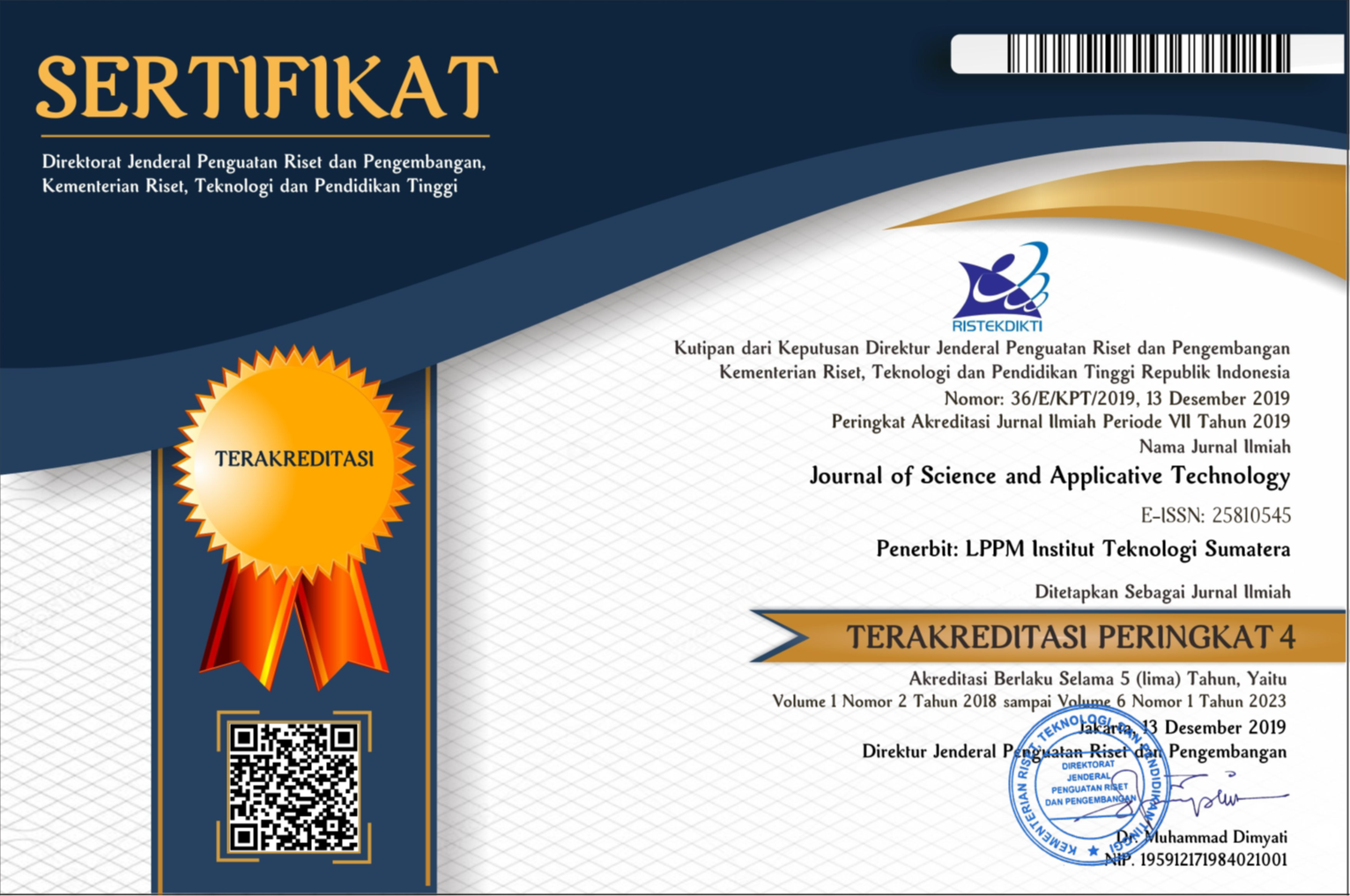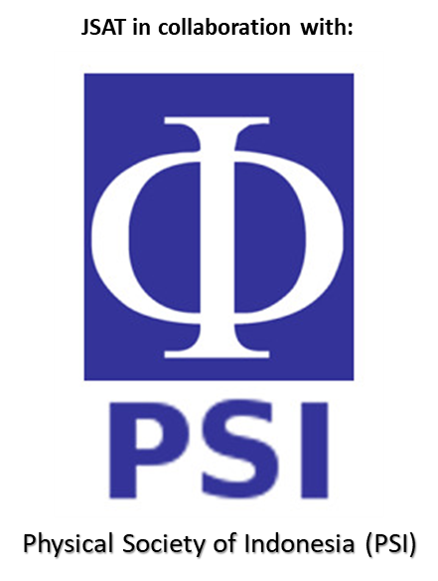Evaluation of surface properties of betung bamboo (Dendrocalmus asper) strands under various heat treatment duration and temperature
Abstract
The abundance, rapid growth characteristics and good mechanical properties have made betung bamboo as good alternative materials to replace the slow growing wood. To adress the susceptibility to insects and water attack, the making of bamboo composites, using resin as matrix, has been widely practiced. Thus, the surface properties of bamboo strands are crucial to determine the optimum interaction with resin. This study evaluate the effect of heat treatment to improve the surface properties of bamboo strands, such as the wettability and the color change. Beforehand, the freshly cut bamboo was cut, cleaned and sand-grinded. The heat treatment was done at 140o and 160oC for 1, 2, and 3 hours. After cooling down to room temperature, the contact angle of bamboo’s surface was measured by sessile drop methode. The wettability was indicated by constant of contact angle change rate, K. Besides, the change of color was also determined. After the experiments, it was obtained that the bamboo surface tends to be more hydrophobic and has darker color with longer duration of heat treatment. Higher temperature and longer duration of heat treatment can cause more evaporation of liquid inside bamboo and decrease hydrophilicity of the surface.
Downloads
References
[2] I. . Hunter, “Bamboo resources, uses and trade: The future?,” J. Bamboo Ratt., vol. 2, pp. 319–326, Dec. 2003, doi: 10.1163/156915903322700368.
[3] P. Md. Tahir, Bonding with Natural Fibres, vol. 1. Serdang: Universiti Putra Malaysia Press, 2013.
[4] F. Febrianto, I. Sumardi, W. Hidayat, and S. Maulana, Papan Untai Bambu Berarah-Material Unggul untuk Komponen Bahan Bangunan Struktur, 1st ed. Bogor: IPB Press, 2017.
[5] S. Dransfield and E. A. Widjaja, Bamboos. Leiden: Backhuys ublishers, 1995.
[6] R. Anokye, E. S. Bakar, J. Ratnasingam, and B. K. Awang, “Bamboo Properties and Suitability as a Replacement for Wood,” PJSRR Pertanika J. Sch. Res. Rev., vol. 2, no. 1, pp. 63–79, 2016, doi: 10.13140/RG.2.1.1939.3048.
[7] C. Ye, Y. Huang, Q. Feng, and B. Fei, “Effect of Hygrothermal Treatment on the Porous Structure and Nanomechanics of Moso Bamboo,” Sci. Rep., vol. 10, no. 1, pp. 1–11, 2020, doi: 10.1038/s41598-020-63524-4.
[8] S. Maulana, “Sifat fisis, mekanis, dan keawetan oriented strand board bambu andong dan betung dengan perlakuan steam pada strand sena maulana,” IPB University, 2018.
[9] S. B. Association, “Oriented Strand Board in wood frame construction,” Ontario, 2005.
[10] F. Febrianto et al., “Effect of bamboo species and resin content on properties of oriented strand board prepared from steam-treated bamboo strands,” BioResources, vol. 10, no. 2, pp. 2642–2655, 2015, doi: 10.15376/biores.10.2.2642-2655.
[11] Adrin, F. Febrianto, and S. Sadiyo, “Properties of oriented strand board prepared from steam treated bamboo strands under various adhesive combinations,” J. Ilmu dan Teknol. Kayu Trop., vol. 11, no. 2, pp. 109–119, 2013.
[12] S. Maulana, B. D. Purusatama, N. J. Wistara, and I. Sumardi, “Pengaruh Perlakuan Steam pada Strand dan Shelling Ratio terhadap Sifat Fisis dan Mekanis Oriented Strand Board Bambu ( Effect of Steam Treatment on Strand and Shelling Ratio on the Physical and Mechanical Properties of Bamboo Oriented Strand Board ).”
[13] A. Fatrawana et al., “Changes in chemical components of steam-treated betung bamboo strands and their effects on the physical and mechanical properties of bamboo-oriented strand boards,” Eur. J. Wood Wood Prod., vol. 77, no. 5, pp. 731–739, 2019, doi: 10.1007/s00107-019-01426-7.
[14] S. Maulana, I. Sumardi, N. J. Wistara, N. H. Kim, and F. Febrianto, “Effects of compression ratio on physical and mechanical properties of bamboo oriented strand board,” IOP Conf. Ser. Mater. Sci. Eng., vol. 935, no. 1, pp. 0–2, 2020, doi: 10.1088/1757-899X/935/1/012063.
[15] S. Shao, Z. Jin, G. Wen, and K. Iiyama, “Thermo characteristics of steam-exploded bamboo (Phyllostachys pubescens) lignin,” Wood Sci. Technol., vol. 43, no. 7–8, pp. 643–652, 2009, doi: 10.1007/s00226-009-0252-7.
[16] M. Nishida, T. Tanaka, T. Miki, T. Ito, and K. Kanayama, “Multi-scale instrumental analyses for structural changes in steam-treated bamboo using a combination of several solid-state NMR methods,” Ind. Crops Prod., vol. 103, pp. 89–98, Sep. 2017, doi: 10.1016/j.indcrop.2017.03.041.
[17] H. Yun, K. Li, D. Tu, and C. Hu, “Effect of heat treatment on bamboo fiber morphology crystallinity and mechanical properties,” Wood Res., vol. 61, pp. 227–234, Jan. 2016.
[18] Y. Zhang, Y. Yu, and W. Yu, “Effect of thermal treatment on the physical and mechanical properties of phyllostachys pubescen bamboo,” Eur. J. Wood Wood Prod., vol. 71, pp. 61–67, 2012.
[19] Y. Li et al., “Quasi-static and dynamic nanoindentation to determine the influence of thermal treatment on the mechanical properties of bamboo cell walls,” Holzforschung, vol. 69, no. 7, pp. 909–914, 2015, doi: 10.1515/hf-2014-0112.
[20] L. Qin, “Effect of Thermo-Treatment On Physical, Mechanical Properties and Durability of Reconstituted Bamboo Lumber: Ph. D. dissertation. Chinese,” Chinese Academy of Forestry, 2010.
[21] H. Wang, H. Wang, W. Li, D. Ren, and Y. Yu, “Effects of moisture content on the mechanical properties of moso bamboo at the macroscopic and cellular levels,” BioResources, vol. 8, no. 4, pp. 5475–5484, 2013, doi: 10.15376/biores.8.4.5475-5484.
[22] G. Ziesing, “The Determination of Surface Tension by Sessile Drop Measurements, with Application to Mercury,” Aust. J. Phys., vol. 6, no. 1, p. 86, 1953, doi: 10.1071/ph530086.
[23] C. Hill, “Wood Modification: Chemical, Thermal and Other Processes,” 2006.
[24] Y. Zhang and W. Yu, “Changes in Surface Properties of Heat-Treated Phyllostachys pubescens Bamboo,” BioResources, vol. 10, no. 4, pp. 6809–6818, 2015, doi: 10.15376/biores.10.4.6809-6818.
[25] O. Bobleter and H. Binder, “Dynamic hydrothermal degradation of wood.,” Holzforschung, vol. 34, no. 2, pp. 48–51, doi: 10.1515/hfsg.1980.34.2.48.
[26] F. Meng, Y. Yu, Y. Zhang, W. Yu, and J. Gao, “Surface chemical composition analysis of heat-treated bamboo,” Appl. Surf. Sci., vol. 371, pp. 383–390, 2016, doi: https://doi.org/10.1016/j.apsusc.2016.03.015.
[27] A. Burmester, “Effect of heat-pressure-treatments of semi-dry wood on its dimensional stability,” 1973.
[28] J. Bourgois and R. Guyonnet, “Characterization and analysis of torrefied wood,” Wood Sci. Technol., vol. 22, no. 2, pp. 143–155, 1988, doi: 10.1007/BF00355850.
[29] R. A. Murda, D. S. Nawawi, S. Maulana, M. I. Maulana, S. H. Park, and F. Febrianto, “Perubahan kadar komponen kimia pada tiga jenis bambu akibat proses steam dan pembilasan,” J. Ilmu Teknol. Kayu Trop., vol. 16, no. 2, pp. 102–114, 2018, doi: 10.51850/jitkt.v16i2.446.g372.
[30] S. Q. Shi and D. J. Gardner, “Dynamic adhesive wettability of wood,” Wood Fiber Sci., vol. 33, no. 1, pp. 58–68, 2001.
[31] Y. Huang, Y. Qi, Y. Zhang, R. Zhu, Y. Zhang, and W. Yu, “Surface properties of novel wood-based reinforced composites manufactured from crushed veneers and phenolic resins,” Maderas Cienc. y Tecnol., vol. 21, no. 2, pp. 185–196, 2019, doi: 10.4067/S0718-221X2019005000206.
[32] J. William D. Callister, Fundamentals of Materiales Science and Engineering. 2001.
[33] M. Nuopponen, T. Vuorinen, S. Jämsä, and P. Viitaniemi, “The effects of a heat treatment on the behaviour of extractives in softwood studied by FTIR spectroscopic methods,” Wood Sci. Technol., vol. 37, pp. 109–115, Oct. 2003, doi: 10.1007/s00226-003-0178-4.
[34] Y. Sun, Y. Zhang, Y. Huang, X. Wei, and W. Yu, “Influence of board density on the physical and mechanical properties of bamboo oriented strand lumber,” Forests, vol. 11, no. 5, pp. 1–12, 2020, doi: 10.3390/F11050567.
[35] K. Srinivasa and K. Pandey, “Effect of Heat Treatment on Color Changes, Dimensional Stability, and Mechanical Properties of Wood,” J. Wood Chem. Technol. - J WOOD CHEM TECHNOL, vol. 32, pp. 304–316, Oct. 2012, doi: 10.1080/02773813.2012.674170.
[36] P. H. G. De Cademartori, B. D. Mattos, D. A. Gatto, and S. Maria, “Colour Responses of Two Fast-growing Hardwoods to Two-step Steam-heat Treatments,” Mater. Res., vol. 17, no. 2, pp. 487–493, 2014.
[37] Y. Chen, Y. Fan, J. Gao, and N. M. Stark, “The effect of heat treatment on the chemical and color change of black locust (Robinia pseudoacacia) wood flour,” BioResources, vol. 7, no. 1, pp. 1157–1170, 2012, doi: 10.15376/biores.7.1.1157-1170.
[38] H. Pelit, “The effect of different wood varnishes on surface color properties of heat treated wood materials,” İstanbul Üniversitesi Orman Fakültesi Derg., vol. 67, p. 1, Jul. 2017, doi: 10.17099/jffiu.300010.
[39] B. Sundqvist, “Colour Changes and Acid Formation in Wood During Heating,” Lulea University, 2004.
[40] X. Huang, D. Kocaefe, Y. Kocaefe, Y. Boluk, and A. Pichette, “A spectrocolorimetric and chemical study on color modification of heat-treated wood during artificial weathering,” Appl. Surf. Sci., vol. 258, no. 14, pp. 5360–5369, 2012, doi: https://doi.org/10.1016/j.apsusc.2012.02.005.
Copyright (c) 2021 Journal of Science and Applicative Technology

This work is licensed under a Creative Commons Attribution-NonCommercial 4.0 International License.
All the content on Journal of Science and Applicative Technology (JSAT) may be used under the terms of the Creative Commons Attribution-NonCommercial 4.0 International License.
You are free to:
- Share - copy and redistribute the material in any medium or format
- Adapt - remix, transform, and build upon the material
Under the following terms:
- Attribution - You must give appropriate credit, provide a link to the license, and indicate if changes were made. You may do so in any reasonable manner, but not in any way that suggests the licensor endorses you or your use.
- NonCommercial - You may not use the material for commercial purposes.
- No additional restrictions - You may not apply legal terms or technological measures that legally restrict others from doing anything the license permits.





















